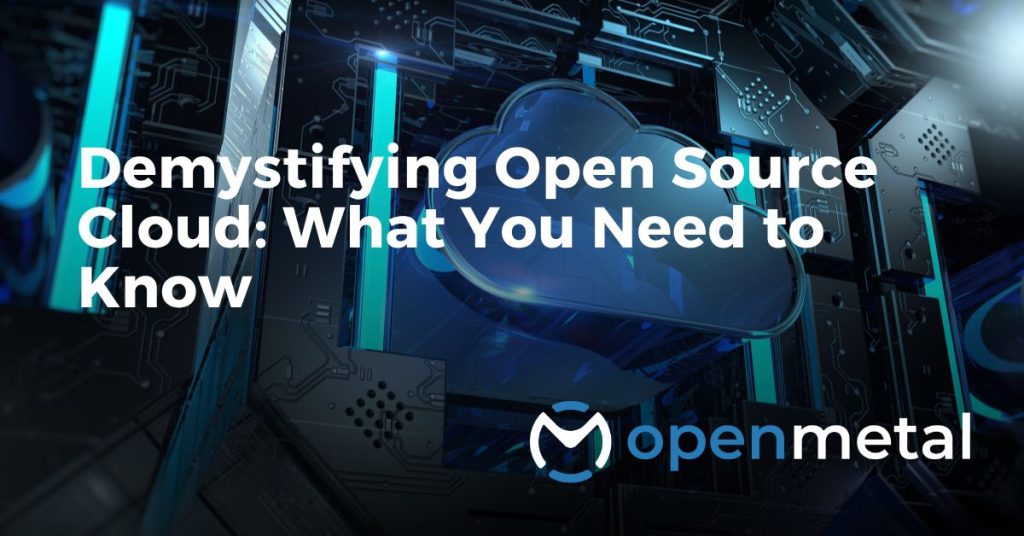Trying to figure out the best cloud hardware to match your needs? We’re here to help! OpenMetal’s Small hosted private cloud hardware offers a good balance of performance, storage, and affordability.
Specs:
- Three hyperconverged servers running OpenStack + Ceph (referred to as the OpenMetal Private Cloud Core)
- Each individual server consists of:
- An Intel Xeon D-2141I CPU – 8 cores / 16 threads, 2.2GHz base and 3.0GHz turbo with 11MB L3 cache
- 128GB DDR4 2933MHz RAM
- 3.2TB NVMe SSD with a 256GB boot disk
- 20Gbps private bandwidth, and 400 Mbps public bandwidth included
Key Advantages of OpenMetal’s Small Hosted Private Cloud Hardware
- Hyperconverged Infrastructure: Simplified management, improved efficiency, and reduced complexity compared to traditional IT setups.
- NVMe SSD Storage: High performance and low latency for demanding applications.
- OpenStack and Ceph: Open source platform for flexibility, customization, and cost-effectiveness.
- Flexible Contract Options: Allows businesses to choose the best pricing model for their needs.
- Affordability: The lower cost of this hardware provides an accessible option for businesses with smaller budgets or specialized dedicated hardware needs.
Considerations
- Limited Resources: This setup is not ideal on its own for resource-intensive applications like video editing, high-performance computing, or large-scale databases. You would likely need to scale up or utilize a multi/hybrid cloud approach.
- Public Bandwidth: The 400 Mbps public bandwidth per server might be a bottleneck for applications with high traffic or large file transfers.
- Management: While OpenStack provides a powerful platform, it requires technical expertise to manage effectively. Businesses might need to invest in training or hire experienced personnel.
So what are some ways you could effectively use this hosted private cloud hardware in your organization? Here are some use cases and applications that are particularly suitable for this setup:

1. Small to Medium-Sized Business (SMB) Infrastructure
Scenario: SMBs with around 50-200 employees that need a reliable and scalable platform for their IT infrastructure. This setup can host core business applications like email servers, file sharing, CRM, ERP, and databases. The private cloud provides better control over data security and compliance compared to public cloud options.
Why this hardware:
1. Right-Sized Performance
- Xeon D-2141l CPU: This Intel Xeon processor, while not the most powerful on the market, offers a solid 8 cores and 16 threads. This provides enough processing power to handle the typical workloads of an SMB, including file sharing, email, databases, CRM/ERP systems, and even lightweight virtualization. It strikes a good balance between performance and cost-effectiveness.
- 128GB DDR4 RAM: This amount of RAM is ample for running multiple applications and virtual machines simultaneously. It ensures smooth operation and prevents performance bottlenecks caused by memory limitations.
2. Storage that Scales
- 3.2TB NVMe SSDs: NVMe drives offer significantly faster read/write speeds than traditional hard drives. This translates to quicker application loading times, faster file transfers, and improved overall system responsiveness. For an SMB, this means increased employee productivity and better user experience.
- Ceph Storage: Ceph’s distributed nature allows you to easily scale storage capacity by adding more servers to the cluster as your business grows. This eliminates the need for costly and disruptive storage upgrades in the future.
3. Virtualization with OpenStack
- Consolidation: OpenStack enables you to run multiple virtual machines on each physical server. This allows you to consolidate your IT infrastructure, reducing hardware costs and simplifying management.
- Flexibility: You can easily create and manage VMs with different operating systems and configurations to meet the specific needs of your applications and users. This adaptability is crucial for a growing SMB.
- Resource Optimization: OpenStack allows for efficient allocation of resources (CPU, RAM, storage) to different VMs, ensuring optimal performance and utilization of the hardware.
4. Network Reliability and Security
- Hyperconverged Infrastructure: The hyperconverged architecture, with its integrated compute, storage, and networking, simplifies management and improves reliability. If one server experiences issues, the others can take over, minimizing downtime.
- Private Network: The dedicated 20 Gbps private network ensures fast and secure communication between VMs and applications within the infrastructure. This is important for data-intensive applications and internal collaboration.
5. Cost Efficiency
- Predictable Monthly Cost: The subscription-based pricing model with no upfront hardware costs makes budgeting easier for SMBs. It also allows for better cost control and scalability compared to traditional on-premises infrastructure.
- Reduced Management Overhead: The hosted nature of this solution means the provider handles hardware maintenance, updates, and basic infrastructure management, freeing up your IT staff to focus on strategic initiatives.
Customer Use Cases
The Tech Sherpa, a managed IT service provider (MSP) located in Kentucky, has expanded their cluster from the base three server setup to seven. Our platform allows for easy expansion and the addition of new hardware as needed to provide complete flexibility and scalability to our customers.
Another MSP uses our Small server hardware to provide OpenStack services to their customers. They mainly provide small instances and storage. The ability to partition each server into completely custom VMs as needed provides our customers with more versatility and control to tailor their infrastructure to exact customer specifications.

2. Development and Testing Environments
Scenario: Software development companies, web agencies, or internal IT teams. This hardware is ideal for creating isolated environments for developers to test code, deploy applications, and experiment with new technologies without affecting production systems. Our customers have found Smalls are a cost-effective and capable way to run proof of concepts, learn and develop processes and policies, and run test simulations.
Why this hardware:
1. Resource Isolation with Virtualization
- OpenStack: This open source platform excels at creating and managing virtual machines (VMs). Developers can spin up isolated environments with specific operating systems, libraries, and configurations without interfering with each other or with production systems. This ensures clean and consistent testing conditions.
- Hardware Support: The Xeon D-2141l CPU with 128GB RAM provides enough horsepower to run multiple VMs concurrently, even with resource-intensive development tools or applications under test.
2. Rapid Iteration and Experimentation
- Fast Storage: NVMe SSDs significantly speed up build times, application loading, and test execution. This rapid feedback loop allows developers to iterate quickly, experiment with different approaches, and identify issues faster, accelerating the development process.
- Easy VM Management: OpenStack’s tools and APIs enable developers to easily create, snapshot, revert, and delete VMs as needed. This streamlines the process of setting up and tearing down test environments, saving time and effort.
3. Scalability for Diverse Needs
- Flexible Resource Allocation: OpenStack allows for fine-grained control over resource allocation (CPU, RAM, storage) to VMs. This means you can create totally custom VMs with varying configurations to match the specific requirements of different projects or testing phases. Many large cloud providers only offer preset hardware configurations with limited (or no) options for customization.
- Ceph Storage: Ceph’s distributed storage scales easily, accommodating growing storage needs for projects, repositories, and test data.
4. Cost-Effectiveness for Agile Teams
- On-Demand Infrastructure: Our monthly subscription model aligns well with the dynamic needs of development teams. You can easily scale resources up or down as needed, avoiding large upfront investments in hardware.
- Reduced Operational Overhead: The hosted nature of the solution means less time spent on hardware maintenance and infrastructure management, allowing developers to focus on coding and testing.
5. Collaboration and Integration
- Private Network: The 20 Gbps private network facilitates fast and secure communication between VMs, enabling efficient collaboration among developers and seamless integration with other development tools and services.
- OpenStack Ecosystem: OpenStack’s open architecture and API-driven approach make it easy to integrate with popular development tools, CI/CD pipelines, and version control systems, promoting a streamlined workflow.
Customer Use Case
Kasm Technologies provides Desktop as a Service and uses our Small hardware to run virtual desktop infrastructure (VDIs) for Linux and Windows through OpenStack. Check out their article and video here to learn more about how they’re taking advantage of this hardware, along with a walkthrough of how to deploy Linux and Windows Workspaces through Kasm.
How to Get Started on an OpenMetal Small Hosted Private Cloud
This small hosted private cloud hardware provides a solid foundation for a mix of business applications and use cases. Its affordability and flexibility make it a great option for SMBs and organizations looking for a cost-effective alternative to public cloud or on-premises infrastructure.
If our Small hardware seems like a match for your needs, we offer a few options to get started:
Apply for Trial View Catalog & Pricing Request a Quote
Questions? Contact us.
Read More on the OpenMetal Blog
How to Create a DevOps Culture In Your Workplace
If your organization is new to exploring the possibilities with DevOps, it may be a challenge to rethink and rework what you’re currently doing. So how can you effectively create a DevOps culture within your workplace, with as little time + money wasted as possible?
Demystifying Open Source Cloud: What You Need to Know
If you’re searching for a solution to take full control of your infrastructure, you might have come across the term “open source cloud.” But what exactly is it? In this comprehensive blog, we’ll dive into the concept of open source clouds and explore why they are the ultimate key to empowering organizations.
How to Build a Private Cloud Using OpenStack
So you want your own private cloud! Now you have to figure out your options for getting there. As a huge fan of open source, we recommend you build a private cloud on OpenStack. Here are some tips and guides for doing so.





































